Much as you might love spending time in your motorhome, the excitement of parking up and heading off to explore somewhere new is hard to beat. What better way to do that than to trade one set of wheels for another?
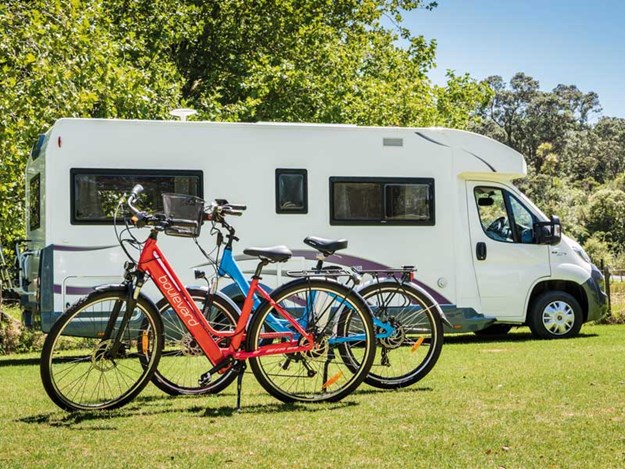
The electric bike (e-bike) – essentially a bicycle that gives you the option of assistance from a motor – is zooming ahead in popularity, and sitting happily astride some impressive stats. According to Statistica.com, by 2023, global e-bike sales are expected to hit some 40 million; locally, around 27,000 bikes were imported into New Zealand in 2018.
They’re the fastest growing category in the global cycling industry. And it’s easy to see why: they’re eco-friendly, cost-effective, and – just to set the record straight for those who regard having a motor as ‘cheating’ – e-biking is a great way to keep active.
Studies have shown e-bikes come with a range of health benefits, with a recent Swiss study suggesting they’re as good as regular bikes for increasing fitness, at least in obese people.
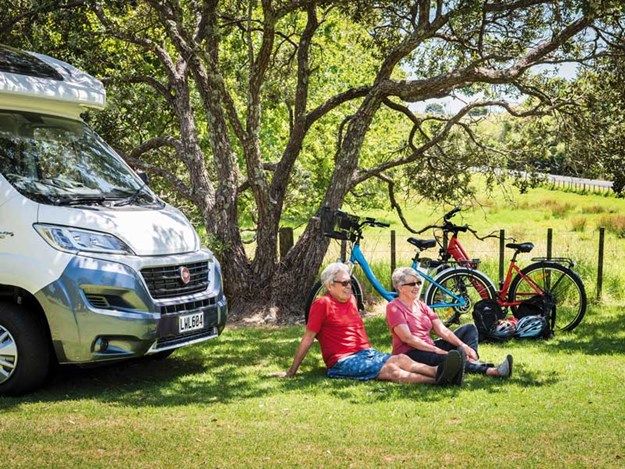
“Many people who purchase e-bikes end up biking a lot further than they previously would have, and some would never have biked if it had not been for an e-bike,” says Brad Mitchell, director of e-bike importer, Watt Wheels.
The range of models, and their quality, has improved vastly since e-bikes first emerged on the scene. “The first models basically were city or mountain bikes; now there are folding, commuter, town, e-trikes, cargo bikes, drift bikes,” says Brad.
Today’s e-bikes are sleeker and better looking, too, made from materials like aluminium and carbon fibre, with batteries increasingly concealed inside the bike, along with motors.
The basics
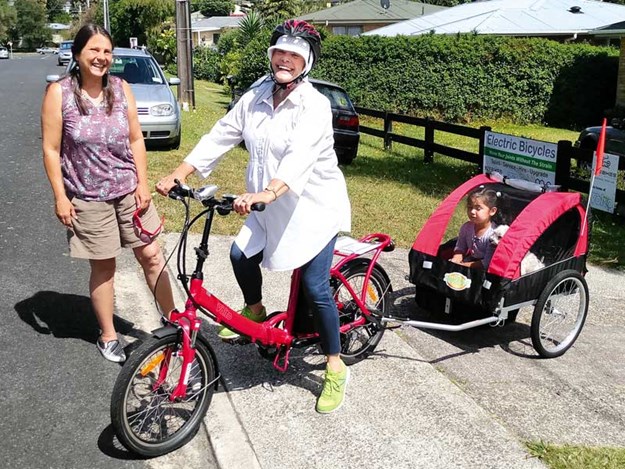 |
Even the littlies and pets can join in on your e-bike adventures! |
So what is an e-bike? It’s essentially a bicycle with a battery and electric motor fitted to it, helping to propel you along. Pedal assist is a mode that only provides power when you are pedalling (pedelec). There’s also throttle assist, and some bikes have both.
All electric bikes have pedal assist; you choose how much assistance you want via a control panel. The higher the level the more help the motor offers, and the less effort you need to put on the pedals. Some bikes also feature a thumb or twist throttle. When this is engaged, you don’t have to pedal, but you’ll use up the battery faster.
Colin Faulkner, who runs hire company 219 E-Bikes in Alexandra, Central Otago, offers pedal assist bikes with an optional thumb accelerator. They’re useful when starting on a hill, but personally he’s not a fan.
“Thumb acceleration is a way to waste power. Using pedal assist, you take only the power you need, and you know what gear you should be in.”
Again, it depends on your personal needs. Says Andreas Steppat, of NZ Ebikes in Tauranga. “We have a lot of elderly customers and they love their throttle. It makes it so much easier to take off or go fast over a busy intersection.”
Let’s torque systems
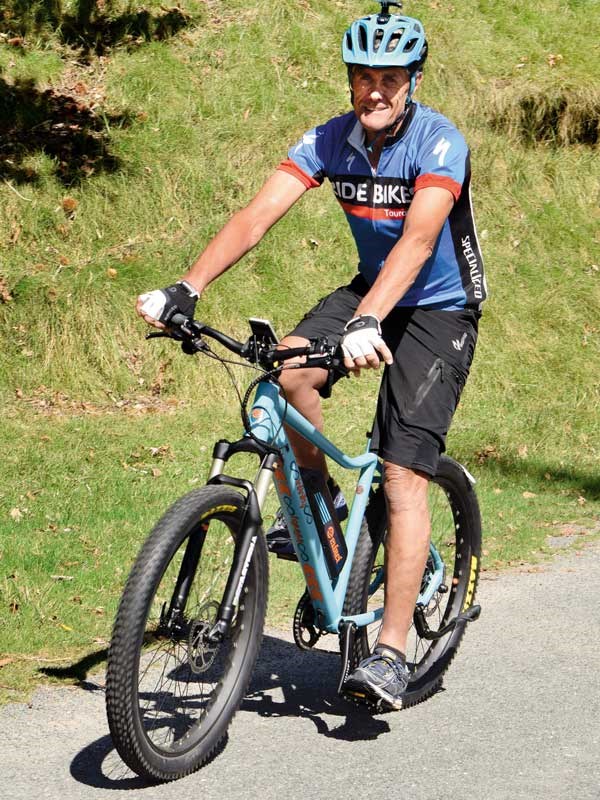 |
E-bikes are a great way to stay active and have fun |
The type of motor you choose is really down to your needs and preferences. “When buying an e-bike one of the first questions you need to ask yourself is mid-drive or hub drive?” says Brad.
A hub motor usually sits in the middle of the rear bike wheel, sometimes the front. Mid-drive is closer to the centre of the bike. It sits where the crank is and directly drives the chain.
There are pros and cons to both. One drawback of hub motors, for example, is they’re usually single speed – okay for urban riding on the flat, or light hills, but for hill climbing, not so much.
A plus, says Andreas, is they’re low-cost and easy to maintain. “The hub motor directly drives the wheel and can work independently of the rider, so it’s a good option with a throttle. For most average cyclists they also offer enough support to get them up a hill. But for steep hills and going off-road they might not supply enough torque.”
A mid-drive allows the motor to use the gears at the rear wheel and produces a much higher torque on the rear wheel. But the crux, says Andreas, is “You must know when to change the gear. For savvy riders this is a no-brainer, but for newbies it can be overwhelming.”
Mid-drive motors are also harder to maintain, as the higher torque will wear out the chain and derailleur system much faster. Andreas reckons mid-drive is great for high end bikes ($4000 and over) with good components and riders who know how to work the gears. They’re also great for tackling steep hills.
Riding on varied terrain and want a good multi-purpose bike? While it can be hard to narrow down the perfect e-bike, “good all-rounders can be a little easier to identify,” says Luke Swift, store manager at Bike Barn Albany.
“A mid-drive motor system such as a Bosch or Shimano system typically will deliver a decent range per charge and higher end reliability. With good amounts of power, even in the entry level offerings of these options, this is suitable for on or off-road use of any kind.”
The law
In New Zealand, an e-bike is a Class AB vehicle. There is no speed limit other than what the road signs tell you. Power is limited to 300W (higher than that, and you have to register it).
Further information
- For a list of New Zealand bike clubs, visit cyclingnewzealand.nz
- The Love to Ride association, at lovetoride.net/nz, is a fun way to get involved too.
- The free Great Rides app showcases some of New Zealand’s best rides, with a detailed description of each trail.
- Thanks to Electrify.nz Auckland Central for the use of the red Boulevard e-bike in our feature and cover imagery.
Racking it up...
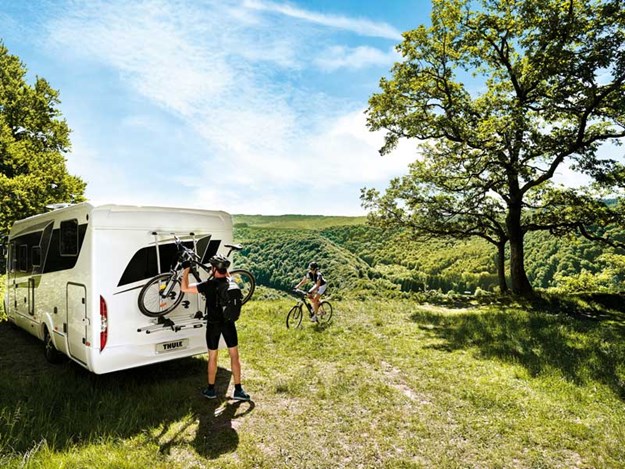 |
Sturdy bike racks are vital for transporting your e-bike |
An added consideration for motorhomers is weight, as e-bikes tend to be on the heavy side. “The higher quality the bike gets, there’s typically a reduction in weight as well,” says Luke. The plus side is that a lighter e-bike will be more natural to ride, and generally easier to manoeuvre.
Brad says a popular option for motorhomers is the Scout range. “They fold up for easier storage and have fat wheels that make riders feel secure and stable.”
But for bikes that you’ll be transporting on the back of your motorhome, it’s important to choose a good quality, sturdy bike rack.
Hamilton-based RV & Marine Supplies (who have an online store and distribute to major RV retailers including RV Super Centre) stock several different styles of Thule bike racks that are suitable for e-bikes, from basic models to fully electric that do the heavy lifting for you.
A good quality bike rack can range in price from around $400 to around $1600. You may also want to consider bike covers to prevent road dust covering your bike, or damage from road chips.
Meet Bernie and Christine
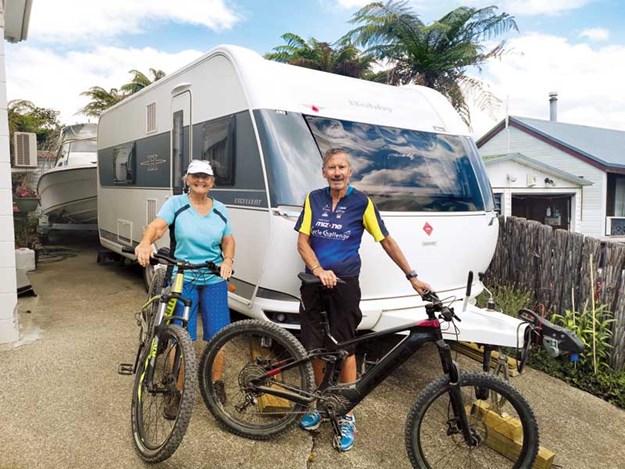 |
Bernie and Christine |
Bernie Priestley, 71, is “a pretty serious mountain bike rider”, who traded his high-end GT Helion carbon bike for an e-assist version – and hasn’t looked back. Not even to check that his less-confident bike-riding partner Christine is still behind him! Thanks to her also swapping to an e-bike, her relative slowness due to a serious cycling accident is no longer an issue, and they can now cycle comfortably together.
Bernie and Christine, from Rotorua, plan to travel a lot in the next few months in their caravan – a Hobby imported from Germany – and cycling will be a big part of their adventures. Bernie had always been a keen golfer, cyclist and runner.
In 2015, he heard about a group of over-60s – the Rotorua Rinkly Riders – who met in the forest twice weekly to ride the trails. Bernie went along, and enjoyed it so much that he’s scarcely played golf since.
“I ride twice a week with these guys, on Grade 3 trails, some Grade 4. Initially it was just on a regular mountain bike. Over the past year a number of the group got e-bikes and were raving about the handling of them. One guy said it’s taken him back to where he was 10 years ago riding bikes. This motivated me to think about buying one. My e-bike is a top-end Trek Powerfly LT 9.7.”
Christine’s bike is a Giant Fathom E+ 3, a hard-tail mountain bike (it has no suspension at the back). At just under $3000, it was cheaper than Bernie’s but “still serious”, he says.
The next consideration was how to transport them. “A lot of people have bike racks on the back of their motorhome, which is all well and good with a relatively lightweight bike. But e-bikes are all at least 20kg.
"My younger son is an engineer, and he made a bracket that fits above the towbar on our tow vehicle so I can put the e-bike rack above the towbar. That keeps the weight of the bikes off the back of the caravan, which could cause it to sway badly.”
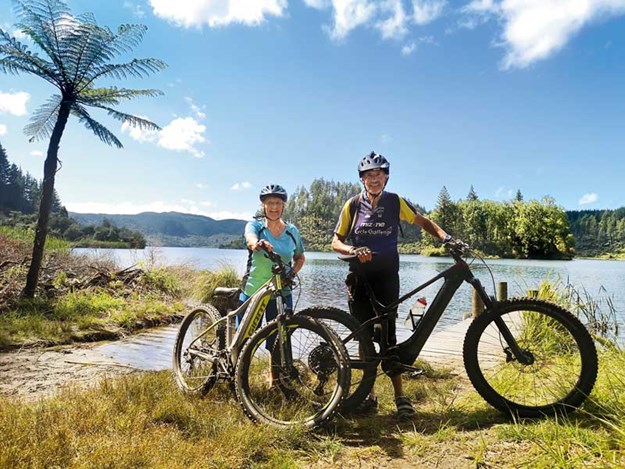 |
With the e-bikes, the couple can enjoy longer rides together |
To charge the batteries in the caravan, Bernie and Christine connect the bike chargers to a 500w pure sine inverter. The two 120 AGM batteries are kept charged by 320w of solar.
Bernie’s fears about getting ‘a free ride’ on an e-bike were soon put to rest. “With our bikes, the motor is only going to assist you when you are pedalling, there’s no throttle on the handlebar. You’ve typically got three or four assist modes.
"Eco is the lowest, then tour, and turbo – which gives a lot of assist. Mine has one in between tour and turbo called EMTB, which can self-select the assist needed based on information the sensors on the bike are picking up. You’ve also got gears like a normal bike, which determine how much effort you put in. So it’s a combo of how much boost you are using, and what gear you are riding in. For example, yesterday, I left the assist in eco the whole time so I was having to seriously work out at times to get up some of the hills.”
And then there are the big rewards, like the couple being able to ride together without one slowing the other down. Some years ago Christine had a serious cycling accident at Craters of the Moon in Taupo and had eight months off work with a smashed shoulder.
“With just our ordinary bikes, when we’ve tried riding together, Christine is so much slower. But with the e-bikes we can do longer rides together, rail trail-type rides. She is slow going down hills but she can just raise the assist on her e-bike and get pretty much in behind me going up a hill.”
Buying tips
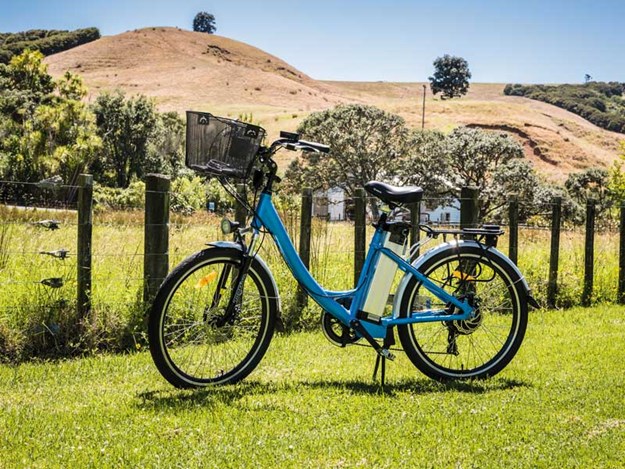 |
This ‘step thru’ bike from Dynamo bikes has a low frame making it easy to get on and off |
- Buy from a recognised dealer or agent who can offer backup. You can pick up a cheap bike on Trade Me or other platforms, but you need to be sure you can get replacement parts. Look at the company behind the brand. Are they established?
- “Ask, do they sell from a proper bike shop or through garage agents with almost no knowledge of the technology,” says Andreas. He advises against buying online as “the buyer has to assemble the bike and there is always the question of what happens if there’s a problem or warranty failure”.
- Assess what you want to do most with your bike. For example, says Luke, “If you want to go off-road, think about whether the tyres will be adequate.”
- Check the type of lithium cells they use. “Many cheaper brands use cheap Chinese cells which do not last or end up having issues in the first year or two,” says Brad.
- Find out how much a replacement battery costs. Find out if the bikes are truly designed for New Zealand, or are just a ‘knock-off’. Try before you buy. Take the bike for a test ride if you can and see if it feels good to you.
The nitty gritty
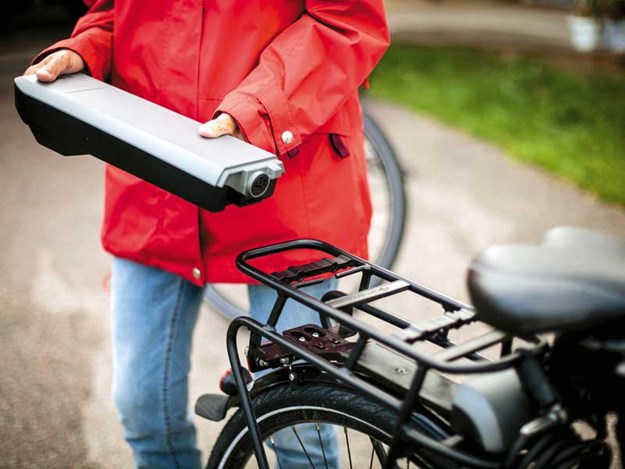 |
Consider the cost of a battery upgrade when choosing your bike |
It’s dizzying, the array of bikes on offer, but there are some bottom-line factors to consider.
Brakes: Disc brakes are standard, says Andreas. “Don’t take a bike with V-brakes. An e-bike, being more heavy and faster, needs to have proper brakes.” Also ask, are the brakes set up for New Zealand? “It should be, front brake right hand, rear brake left hand. European bikes are the other way round. Braking with a bike with a ‘wrong’ setup can be dangerous for an inexperienced rider.”
Battery: To power up the battery, you simply plug the charger in to a 230/240v powerpoint or auxiliary point in a car or motorhome. The rule of thumb, says Andreas, is “If you’re using your bike recreationally around town 13Ah might be fine, for rail trails we recommend at least 16Ah. Don’t choose a bike with no battery upgrade option. If you’re thinking about getting two bikes, the price for a replacement battery gets very important.”
Frame: This should meet your size and riding abilities. Riders with joint issues might want to choose low-step frames that make it easier to get on and off. “Taller riders should consider frames with bigger reach and adjustable stem,” says Andreas.





